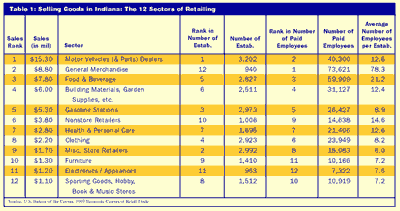Kelley School Forecasts Solid 2001
The Kelley School of Business at Indiana University recently issued its forecast for the national and state economic situation in 2001. The forecast is based on a large econometric model of the United States, a model constructed and operated by the Center for Econometric Model Research (CEMR) at the Kelley School in Bloomington.
Based on the results of the model, CEMR predicts continued expansion of overall economic activity in both the nation and Indiana, but with slower growth than has occurred in recent years.
Real U.S. gross domestic product is forecast to rise just over 3% next year, in contrast to an expected 5% jump in 2000. While this decline in growth rate is significant, it's also true that a GDP growth rate of 3% is still very healthy.
Businesses are expected to continue the rapid rate of investment in new equipment that has characterized the last three years. The CEMR forecast calls for a 10% increase in equipment investment. Assuming that takes place, the strong productivity gains of recent years will continue, and inflation should remain low.
The Indiana economy is forecast to grow somewhat more slowly than the U.S. economy, as weakening nationwide demand for autos and housing hits Indiana's large manufacturing sector. Outside those two industries, however, economic activity in our state should remain at high levels.
For information on subscribing to the CEMR quarterly forecasts, send e-mail to ibrc@iu.edu or call the Kelley School in Bloomington at (812) 855-5507.
The Busiest Month
December—the biggest shopping month of the year. For those of us who like facts and figures to support our clichés, this statement is borne out by annual retail sales figures from the U.S. Department of Commerce (see Figure 1).
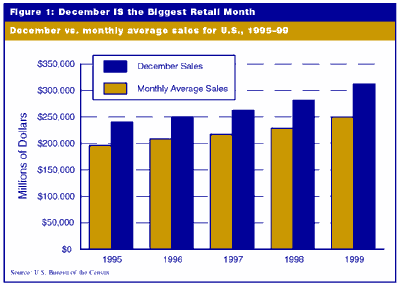
Where did millions of Hoosiers shop during the first December of the 21st century—or was it the last December of the 20th century? We went to press before the December 2000 figures were released, but we can use statistical history as our guide. Looking at the 12 sectors that comprise the retail trade industry (see Table 1), we see that car dealers rank first in both annual sales and in the number of establishments. However, it is unlikely that a new car was found under very many Christmas trees, particularly when the National Retail Federation's annual Holiday Mood Survey (www.nrf.com) estimates consumers will spend an average of $836 each on holiday gifts. Based on sales (again see Table 1), most people will likely frequent stores in the general merchandise sector, and quite possibly they will purchase their holiday gifts and groceries at one of the many new warehouse clubs and superstores (a category within the general merchandise sector) that are dotting the retail landscape throughout Indiana and the nation.
There were 49 such warehouse clubs and superstores counted in the 1997 Economic Census in Indiana, according to recently released results. This segment of the retail trade's general merchandising sector (see Figure 2) consists of "warehouse clubs, superstores or supercenters that are primarily engaged in selling a general line of groceries in combination with general lines of new merchandise such as clothing, furniture and appliances".
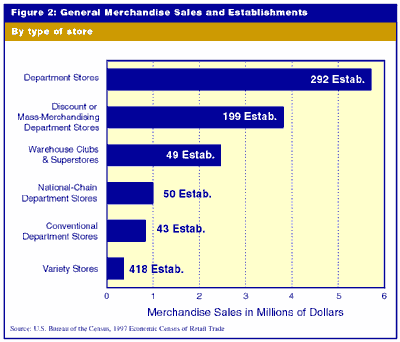
While such stores comprise less than 1% of all retail establishments in the state, they account for $2.5 billion in annual sales—or 28% of all general merchandise sales in Indiana. Put another way, each of those 49 superstores or warehouse clubs sold an average of $50 million in goods in 1997 (the latest year for which such detailed sales information is available from the federal government).
What are these stores? While the Economic Census, under strict federal rules of confidentiality, cannot divulge names or locations, we can surmise from the definition cited above that stores such as Sam's Club, Meijer, and Super Wal-Marts and Super K-Marts would fall into this category. Some quick research on the Internet provided information on specific superstores in Indiana that meet the criteria of the Census definition.
There are 24 Meijer superstores in Indiana today (compared to five in Illinois, eight in Kentucky, 35 in Ohio and 71 in Michigan—its home state). They are located in large and medium-size cities across the state—from Michigan City to Merrillville and Richmond to Jeffersonville. The walmart.com Web site yielded a list of approximately 26 Wal-Mart Super Stores (as opposed to regular Wal-Marts) in Indiana.
In the warehouse club category, Sam's Club listed 14 locations in Indiana, 27 in Illinois, five in Kentucky, 21 in Michigan and 24 in Ohio. On the K-Mart Web, it was not possible to cull out the "Super" (or Big K) stores.
What About Holid'e' Commerce?
E-commerce is the hot topic among retailers (while they in turn hope it is a hot item among consumers). The big question among merchandisers is "can we succeed by cyber-trying?" The Retail Institute at Purdue University predicted in November 2000 that the "amount of Christmas shopping consumers will do online...will triple from last year's $2 billion to more than $6 billion."
The Retail Trade Census, based on NAICS, the new industrial coding system, gives us a glimmer of e-commerce from 1997. Electronic shopping and mail-order houses are within a category called non-store retailers. These retailers sell all types of merchandise by means of mail or electronic media such as interactive television or the Internet. There were 176 such establishments in Indiana, with sales of $2.9 billion and with 8,269 paid employees. These electronic shopping/mail-order houses averaged annual sales of $16.5 million per establishment, based on the 1997 Census. These sales figures do not, of course, include Internet sales by establishments that are classified elsewhere in the Retail Trade industry (such as warehouse clubs, superstores, clothing stores or car dealers).
Because e-commerce data were not captured in the economic census the way it actually works now, the Census Bureau has begun collecting national e-commerce retail sales figures as part of its monthly retail survey (www.census.gov/mrts/www/mrts.html). That survey, in its infancy, shows sales of $5.5 billion for the second quarter of 2000, an increase of 5.3% from first quarter 2000. Firms included in this survey are asked each month to report e-commerce sales separately from other sales. Over time, this approach to e-commerce should provide us with a realistic view of Web-based retail sales, as more and more traditional retailers begin to use the Web as another outlet for their goods.
County Highlights
The majority of merchandise sales are still handled in person—that is, the buyer goes to the physical location of the establishment, pays for the goods and takes them away. Modern mail-order sales have been with us since the 19th century, but have never comprised the percentage of sales that Web-based retailers hope to capture from traditional in-store, in-person sales. It is no surprise that generally, our most populous counties also generate the most retail sales (see Table 2).
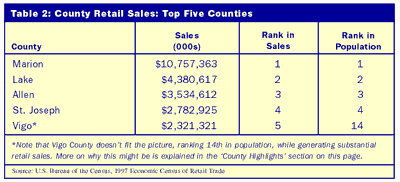
In the meantime, because population size has such a big impact on sales, how does one compare counties? One way is to try to eliminate the population-size factor by creating a per capita comparison. Figure 3 shows this comparative statistic, arrived at by dividing sales by the total population (in this case, the estimate for 1997).
Click on map below to see larger version with data.
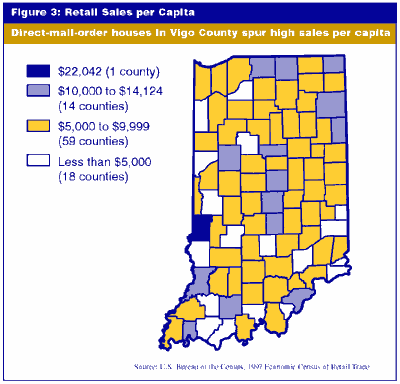
One should not assume this figure compares the consumptive habits of a state's or county's people, as the sales could be coming from people living outside the county. Certainly this will be the case among counties that share state lines or in retail hubs, such as Marion County. And we come back to Vigo County, with its estimated population of 105,313 (about one-eighth the size of Marion County), ranking No. 5 in sales and No. 1 in retail sales per capita (see Table 3).
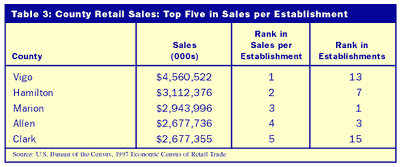
Why is this? Does Terre Haute offer a broader selection of goods than those offered at the malls and discount centers in Indianapolis? Investigation among other sources (because the census cannot, by penalty of law, divulge specific company information) finds that Vigo County is home to a retailer that provides goods many Americans want—music and videos. That retailer is Columbia House, one of the nation's largest direct-sales mail-order music publishing concerns.
Conclusion
Once the gift wrap had hit the waste bin, we were not thinking of buying but rather of paying. Consumer debt as a percent of disposable income was at 13.70 in the second quarter of 2000, compared to 13.39 in the second quarter of 1999, according to the Federal Reserve Board. Even with the traditional January white sales to tempt us back to the stores, sales typically return to a more usual monthly average. But our main point here was to illustrate the depth that can be obtained from the 1997 Economic Census, a depth that offsets the datedness of the material.

